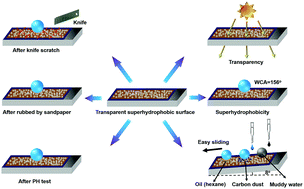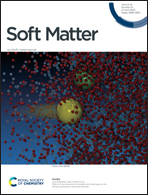Fabrication of a waterborne, superhydrophobic, self-cleaning, highly transparent and stable surface†
Abstract
Superhydrophobic surfaces have received tremendous attention worldwide. However, the synthesis of a superhydrophobic surface possessing two paradoxical characteristic properties – stability and transparency, is a vital aspect that has been addressed in this paper. The surface was fabricated by an environmentally friendly process, which used distilled water for the dissolution of SiO2 nanoparticles in the presence of surfactants, instead of organic solvents. Moreover, the surface was transparent and had self-cleaning properties and stability. The optimal balance of roughness and multi-porous structure imparted excellent transparency to this surface. Importantly, both the conformal coating and the SiO2 nanoparticles embedded in the half solidified conformal coating contributed to the excellent stability, thus overcoming the paradox. The surface could withstand a temperature of 150 °C for 24 h and also different temperature regimes between 0–200 °C for 2 h. In addition, this surface could resist repeated scratches and abrasion as well as strong acids and alkali. The surface achieved its self-cleaning ability due to the introduction of surfactants containing the F element. This simple but novel strategy and surface have the advantages of high safety, low cost and environmental-friendliness.



 Please wait while we load your content...
Please wait while we load your content...